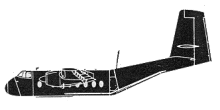Incident Overview

Description
The DHC-4A Caribou aircraft was en route from Calgary to Ross River where it was to be used to transport silver ore concentrate from the mines at Plata to Ross River. On board were two pilots, two company aircraft maintenance engineers to service the aircraft, and about 5,500 pounds of aircraft parts and equipment to support the operation of the aircraft in Ross River. One refuelling stop was made at Fort Nelson, after which the aircraft proceeded on an IFR flight plan to its destination. Ross River has no published instrument approach and is situated in a valley in mountainous terrain. It was necessary to overfly Ross River, proceed 30 miles to the northwest and complete an NDB approach at Faro where the minimum circling altitude is 2,709 feet agl. When below cloud at Faro, the aircraft must then proceed visually up the river valley to Ross River. The Caribou arrived over Faro at approximately 16:15, and an attempt was made to descend below the cloud base which was reported to be 400 to 600 feet agl. When visual reference with the ground was not made, the pilot climbed out to the southeast and informed Faro Community Airport Radio Station (CARS) that he was proceeding to his alternate, Watson Lake. In cruise flight the no. 2 engine began to lose oil, causing the oil pressure to drop to zero. The right engine was then shut down, and the propeller was feathered. A little later, the aircraft was heard flying out to the southeast for an approach to runway 26 at the Ross River Airport. On approach the landing gear had to be recycled because the nose gear did not lock down during the first attempt to lower the gear. The plane was no longer in a position to land, so the captain initiated a go-around. The aircraft passed by the town and then began to lose altitude, descending gradually into the trees. Portions of the right wing were torn off on contact with the trees, and the plane rolled to the right and nosed into the ground. The aircraft then cartwheeled over the embankment and down onto the river shore 20 feet below. CAUSES: “The Canadian Aviation Safety Board determined that a lack of communication at the company’s maintenance facility led to the dispatch of the aircraft with an unsuitable gasket in the right engine, and the subsequent loss of engine oil. A single-engine go-around was attempted when the combination of single-engine performance, a low cloud base, and high terrain surrounding a confined operating area made a successful overshoot uncertain. The flaps were fully retracted before the minimum speed for single-engine flight in the zero flap configuration was achieved.”
Primary Cause
Lack of communication at the company’s maintenance facility leading to the dispatch of an unsuitable gasket in the right engine, resulting in a loss of engine oil.Lack of communication at the company’s maintenance facility leading to the dispatch of an unsuitable gasket in the right engine, resulting in a loss of engine oil.Share on:





